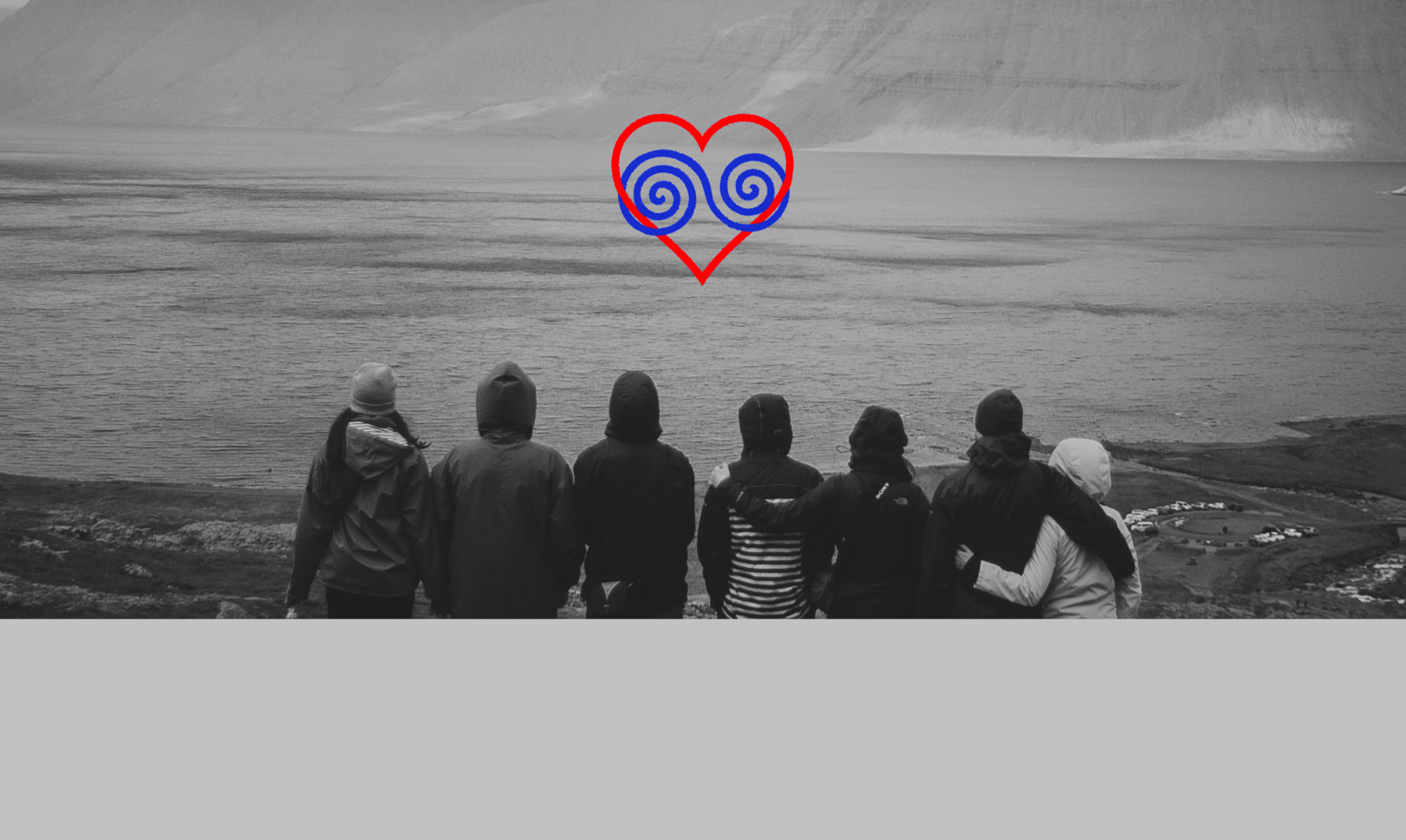You are welcome!
…not only on Valentine’s Day

Throughout our lives – and especially in the moments when we establish relationships – we humans move between different polarities: On the one hand, we naturally want to preserve our individualism, our self, with our own set of thoughts and values. On the other hand, we also usually want to contribute to the well-being of others – on whose support we ourselves are often dependent – and therefore practise altruism. Altruism – according to Wikipedia, a “principle and practice of concern for the well-being and/or happiness of other humans or animals above oneself” – is therefore an important quality in our interpersonal relationships, but – like the proverbial medal – it has another side. And this second side expresses itself in our fear that by becoming too involved with our fellow human beings and due to our longing for participation and inclusion, we will ” disappear”, so to speak as a person, and lose ourselves in conformism by adapting and fitting in (giving up our own individuality to the norms and opinions of the reference group). As a result we head back towards individualism, but sometimes overdo it with our striving and end up with its “medal backside”, egocentrism (self-centeredness, self-indulgence)…
This could be just a nice theory if we weren’t all constantly oscillating through this 4-factor matrix in our multiple relationships. “Us and the others” is THE dynamic basic motif, according to which we orbit like in a dance – sometimes closer and sometimes more distant.
The challenge: to remain true to one’s own values and goals – and at the same time not to succumb to ego-tripping, narcissism or bossiness; to willingly contribute to the overall well-being of a group to which one belongs (also because it can benefit oneself) – and not to do so out of fear to assume responsibility, self-underestimation or the neediness for belonging.
This is why Polyamory so often calls for the cultivation of a balanced self before establishing a multiple relationship, and why I emphasize here on my bLog concerning Oligoamory the creation of the famous “mutual we“, which is supposed to constitute the center of a relationship – in order to enable the perception of being integrated and simultaneously individually appreciated for all participants.
In this way, connectedness, to which I dedicated my last Entry among others, could benefit from the extent of our ability to commit ourselves as individuals and our ability to bond as social beings.
Accordingly, the trauma therapist Maria Sanchez, for example, points out that the amount of ability we have at our disposal to get in contact with ourselves we also possess in an equal amount to get in contact with the outside world…
Ms. Sanchez assumes, however, that most of us in our Western society have already sustained an attachment trauma in early childhood, which resulted from the discrepancy between how we were originally laid out and how the outside (especially our closest caregivers) wanted us to be.¹
Since then, a mostly unconscious part of us would regularly experience ourselves as “disconnected“, especially in situations that would affect that first violation of our innermost core for the sake of approval by attachment figures (or later: loved ones and significant others!).
The social scientist Stefan Ossmann said three years ago in an interview in the Süddeutsche Zeitung: “The scarce commodity [in polyamorous relationships] is not love or sex, but attention.” ²
I would say that this is a fairly accurate observation, considering the many videos, reports and forum discussions on our topic that I have been following ever since – and above all the challenges and difficulties that are regularly presented therein.
A perceived lack of attention today can thus trigger a kind of re-traumatization, so to speak, in which the above-mentioned injured part of us once again registers that there are probably (recently / currently / once more) facets of our being that are still not welcome.
However, what is also not obvious to those affected and the other people involved in the relationship – and what becomes problematic for the relationship as a whole – is that we almost always derive convictions from such an experience that we henceforth impose on ourselves (or we negatively confirm those that were already ingrained anyway).
I say “problematic for the relationship as a whole” because injuries at this level are always rooted in a “we-field”, since the (re)traumatized person acts from an attitude in which they are already over-sensitively focused on external events or already anticipate some menacing occurrence (foreshadowing) – and are no longer well grounded in themselves [By that “The way you are, you’re not ok!” becomes “The way I am, I’m not ok…”].
At this point it can also be seen how a mere feeling (“…something irritated me…”), which would subside after the irritation if it were free of bias, develops into an emotion (= feeling + [biased] evaluation), which continues to remain “triggered” from then on. Thus, a process kicks in that permanently ties up vital energy that could be used much more beneficially elsewhere.
Trauma therapist Sanchez concludes that such processes should contribute – and in any case have contributed – to the fact that we were not allowed or supposed to become mature individuals within certain areas of our personality – and accordingly we never did.
She further concludes that as a result, many of us have developed “chronic symptoms” that correspond to an “inner dictator” who continues to dictate doctrines to us with instructions on how we should behave instead, an “inner critic” who devalues us when we supposedly fail – and above all includes our environment in this downward comparison, as well as an “inner seducer” who tries to temporarily remove us from this field of tension by means of external distractions (addictive structures such as media, drugs, sex, food, cash/consumption, etc…).
In turn, according to Ms. Sanchez, addictive structures are dangerous because, as she puts it, they “swap the stages”: A supposedly “controllable” substitute would be offered instead of a path towards a genuine joy of existence.
Anyone who has followed my bLog up to this Entry knows that this harbours critical potential, especially in multiple relationships, as “situations of insecurity” present a rather different set of challenges than in monogamy – and if only because there is no retreat into the “usual”, because, on the one hand, more “new beginnings” may have to be dealt with – but also because simply the (not even so large) number of individuals involved will produce an ever-changing diversity of nuances, facets and shades of togetherness [in comparison to (only) two long-term partners].
For this reason, especially conflicts in multiple relationships offer the ambivalent potential of having to be overcome – because in the medium term, the parties involved are not likely to be dismissed into a false peace of retreat into their snail shells of silence (which would still be an option with just two people – as our parents’ and grandparents’ generations proved…).
I mentioned it for the first time in Entry 62: ambiguity tolerance is therefore required – which Ms. Sanchez, by the way, calls more specifically and appropriate to the topic of relationships “encounter competence”.
So here we are again invited as individuals (as I indicated from the Latin in-dividuus : “indivisible”) to develop this competence; and because we were unfortunately not allowed to become fully individual (and multi-layered) – as I wrote above – this has also ensured that we are acutely more helpless in the face of every dilemma than would otherwise probably have been the case.
Our beliefs and symptoms consisting of inner dictators, critics and seducers benefit when we remain in such a continuous (dissatisfactory) fight with ourselves and the external circumstances.
Consequently, this would mean for us to get out of this fight. But please not by means of the next seduction in disguise (which could also come in the shape of an ambitious sports program or the strict practice of a spiritual practice…)!
The path to the aforementioned joy of being, to an “I am”, means above all getting in touch with this strangely perceived disconnectedness within us. Even including the sides of us that do not want to feel this disconnectedness at any price and therefore want to dictate that a strong person is strongest when alone*, criticize us as dependent and needy – or who want to distract us from feeling, acknowledging and self-awareness with somewhat inappropriately customized distractions.
In this way we create the opportunity for ourselves to realize that we have very good reasons for everything we feel: We begin to unravel strongly internalized traumas and convictions, because we see through them to the fact that WE HAVE NEVER BEEN WRONG!
And since I already referred in Entry 26 to the consequences of unfavourably acquired thinking when it comes to conflict resolution strategies (key words “win / lose”), this takes us full circle to Ms. Sanchez’s opening remark about how much our ability to make contact “inwardly” has to do with our ability to get into contact “outwardly” – meaning above all with our loved ones.
So our past is indeed always involved when we want to connect with our partners. This is why encounter competence is so important, because this can only succeed in a life where we are in touch with ourselves.
Genuine touch means that this love we all long for does not want to “get rid of” or “change” anything. This love even embraces all our subjunctives of “if” and “might have”: True love gives all aspects a right to exist.
And if – as Stefan Ostmann said above – attention is the scarce commodity that we all covet, then we often realize that we are already taking too little time for ourselves.
This is where encounter competence begins: encountering oneself ever more deeply – in a loving relationship with oneself.
So “I” should be more present; “I” should be happening to a far greater extent…
As far as I’m concerned, the way something like this could potentially take shape was expressed quite appropriately by the British author Matt Haig in his book “The Midnight Library” ³:
»It is easy to mourn the lives we aren’t living. Easy to wish we’d developed other talents, said yes to different offers. Easy to wish we’d worked harder, loved better, handled our finances more astutely, been more popular, stayed in the band, gone to Australia, said yes to the coffee or done more bloody yoga.
It takes no effort to miss the friends we didn’t make and the work we didn’t do the people we didn’t do and the people we didn’t marry and the children we didn’t have. It is not difficult to see yourself through the lens of other people, and to wish you were all the different kaleidoscopic versions of you they wanted you to be. It is easy to regret, and keep regretting, ad infinitum, until our time runs out.
But it is not lives we regret not living that are the real problem. It is the regret itself. It’s the regret that makes us shrivel and wither and feel like our own and other people’s worst enemy.
We can’t tell if any of those other versions would have been better or worse. Those lives are happening, it is true, but you are happening as well, and that is the happening we have to focus on.«
¹ from: YouTube: Transgenerational trauma, Maria Sanchez in an interview with Simon Rilling (25.10.2022, German language only)
Additional thanks to Ms. Sanchez for her therapeutic online offer, from which I quote excerpts in my current Entry (my household has duly paid for access to the content concerned).
² Online service Süddeutsche Zeitung from July 02, 2021, interview by Thomas Bärnthaler with Stefan Ossmann [Polyamory-researcher University Vienna] (SZPLus subscription required; German language only)
³ Matt Haig: “The Midnight Library”, Canongate Books; Main Edition (18. Februar 2021)
* “The strong man is strongest when alone” – Friedrich Schiller: “William Tell”, Act I, Scene 3
Thanks to Valiant Made on Unsplash for the photo!

